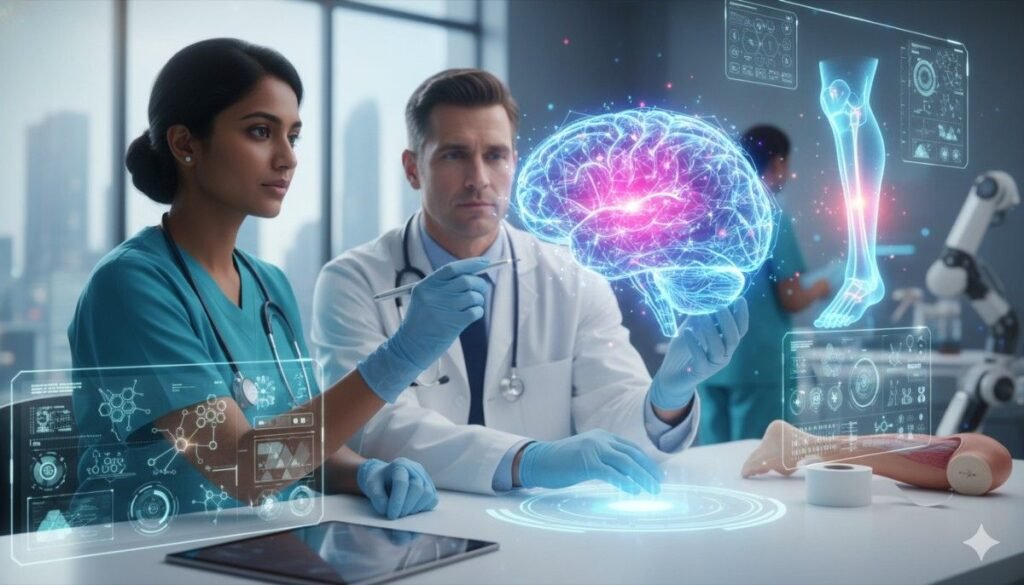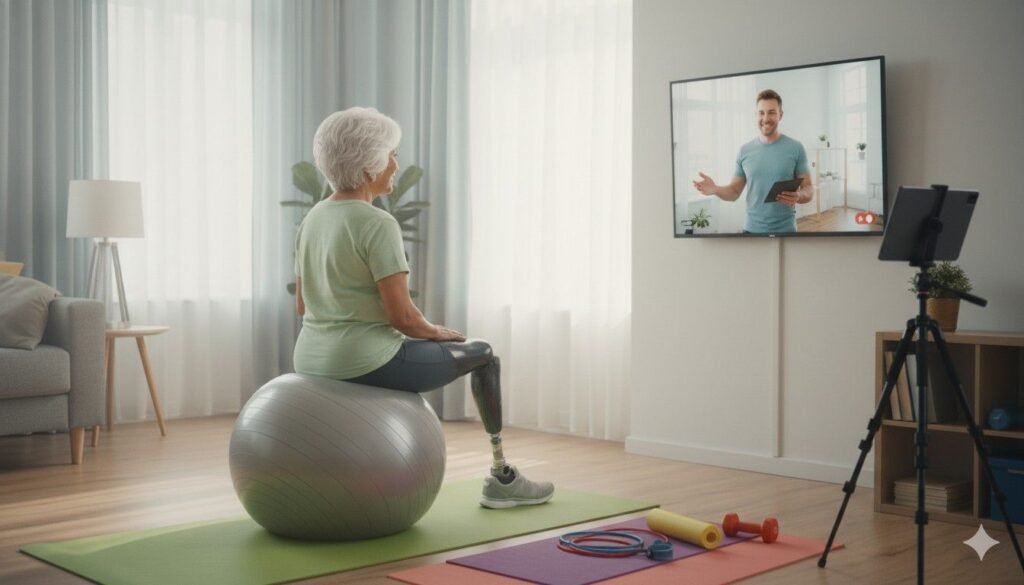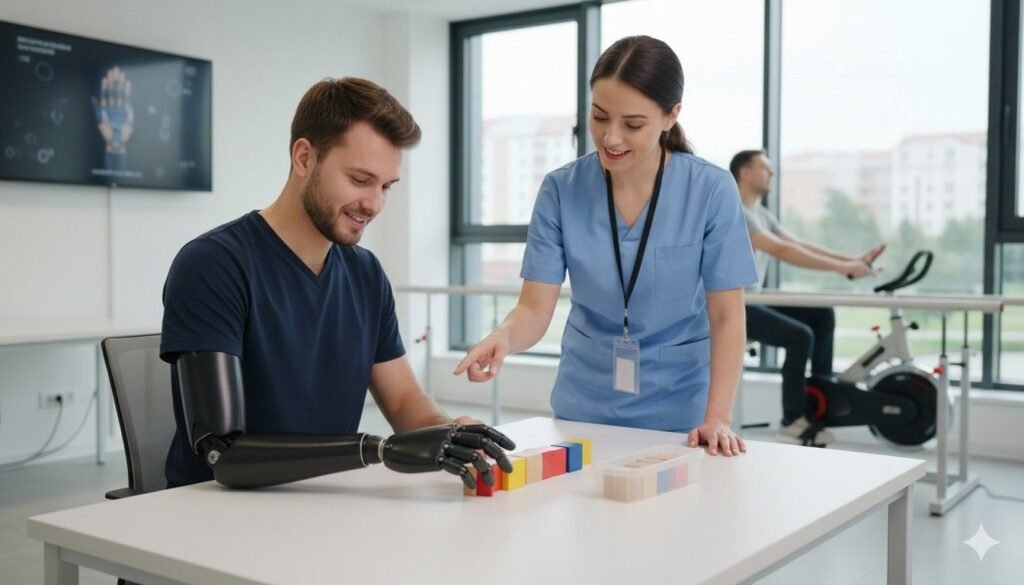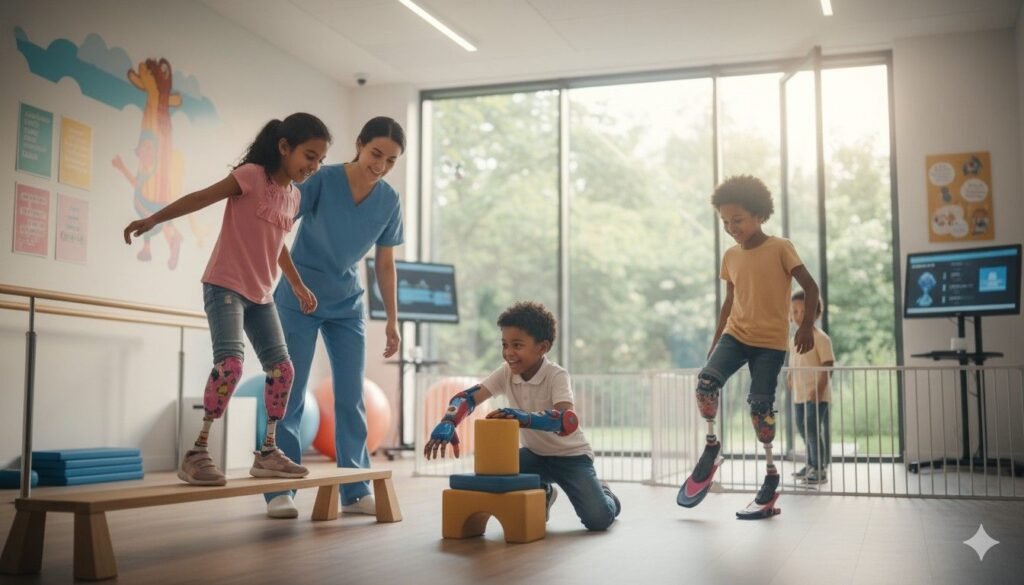Rehabilitation after limb loss is not only about strength and movement.
It is also about motivation, muscle memory, and helping the body relearn patterns that once felt natural.
Tools like EMS and gamified rehab make this process smoother, faster, and more engaging for patients who often feel overwhelmed in the early phase of recovery.
When used together, these tools help muscles wake up, respond better, and gain strength with less fatigue.
They also help patients stay consistent, because the rehab no longer feels like a chore—it becomes something they look forward to.
Doctors today want evidence of real outcome gains, not just new technology for the sake of it.
And the truth is clear: EMS and gamified rehab, when applied properly, improve mobility, speed up recovery, and support long-term prosthetic success.
Why EMS Matters in Early and Mid-Stage Rehab
How EMS Helps Muscles Wake Up After Surgery
After amputation, the muscles that once worked in coordination suddenly lose their usual roles.
Some become weak, some tighten, and some stop firing at the right time.
Electrical muscle stimulation helps re-activate these muscles without asking the patient to perform painful or tiring movements.
The gentle pulses remind the muscles how to contract.
This helps rebuild strength earlier than traditional exercises alone.
Why EMS Reduces the Burden of Fatigue
Fatigue is one of the biggest barriers during early rehab.
Patients tire quickly, especially when they are new to prosthetic training or recovering from long hospital stays.
EMS allows the muscles to work without exhausting the patient.
This maintains strength even on days when the body feels too tired for active exercise.
How EMS Supports Better Limb Control During Prosthetic Fitting
Good limb control comes from strong, coordinated muscles in the residual limb.
If these muscles activate properly, the prosthesis feels easier to control and more stable during weight-bearing.
EMS helps retrain these muscles to contract smoothly and consistently.
This directly improves early socket comfort and alignment success.
The Science Behind EMS-Driven Strength Gains
Why EMS Recruits Muscle Fibers That Exercise Alone Cannot Target

During regular movement, the body activates only a portion of available muscle fibers.
Weaker fibers stay dormant until the body feels stressed.
EMS stimulates a wider range of fibers, including those deep inside the muscle.
This creates a fuller strengthening effect without heavy loads or high effort.
How EMS Improves Blood Flow and Tissue Healing
Electrical pulses increase circulation in the treated area.
More blood flow brings more oxygen, which supports healing and reduces swelling.
For patients with circulation issues or slow recovery, this gentle enhancement helps keep tissues healthy.
Healthy tissue responds better to prosthetic pressure and daily activity.
Why EMS Helps Reduce Post-Surgical Pain
EMS has been shown to reduce residual-limb discomfort and stiffness.
It interrupts pain signals and relaxes tense muscles.
This gives patients the confidence to move more freely.
Less pain means better participation in therapy and faster progress overall.
Understanding Gamified Rehab and Its Psychological Power
Why Motivation Drops During Traditional Rehab
Even the most determined patients struggle when workouts feel repetitive or boring.
They lose focus, skip sessions, and stop pushing themselves.
Gamified rehab solves this by turning therapy into something that feels rewarding.
The sense of achievement keeps the patient engaged day after day.
How Games Create a Sense of Progress
When patients see scores increasing or levels improving, they feel encouraged.
Even small improvements feel satisfying.
This emotional reward keeps them consistent, which is essential for long-term outcomes.
Consistency turns small efforts into real, measurable gains.
Why Gamified Rehab Reduces Fear and Hesitation
Many new amputees feel scared to move fast or try new tasks.
Games create a safe environment where mistakes do not feel stressful.
Patients explore movement with curiosity instead of fear.
This confidence helps them transfer skills into real-world tasks.
How Gamified Rehab Improves Physical Outcomes
How Games Sharpen Balance and Coordination
Balance improves when the brain receives clear, frequent feedback.
Games provide instant correction cues—visual, audio, or movement-based—which accelerates learning.
Patients improve stability without even realizing they are training.
This leads to fewer falls and smoother gait patterns.
Why Reaction Time Improves Through Play
Many games require quick responses.
This trains reaction time, which is vital for avoiding stumbles, navigating steps, or adjusting to uneven ground.
Faster reactions equal safer movement in daily life.
This benefit is especially valuable for older adults.
How Gamified Tasks Strengthen Muscle Groups Naturally
Game-based motions—reaching, stepping, shifting weight—activate muscle groups across the body.
Patients strengthen their limbs without focusing on “exercise.”
This natural strengthening helps with prosthetic control, endurance, and full-body coordination.
The body learns by doing, not by forcing.
Why Combining EMS and Gamified Rehab Creates Stronger Outcomes
How EMS Prepares the Body and Games Train the Mind
EMS strengthens and activates muscles even before the patient is ready for full movement.
It creates a physical foundation—stronger muscles, better circulation, reduced stiffness—that makes functional training safer and easier.
Gamified rehab then uses that foundation to train balance, coordination, reaction time, and confidence through engaging, repetitive tasks.
Together, they allow the body and mind to learn at the same time.
The patient feels ready physically and motivated mentally, which produces faster clinical results.
How the Combination Speeds Up Motor Learning
Motor learning depends on repetition, feedback, and variation.
EMS helps muscles fire correctly, so every repetition in the game becomes cleaner and more effective.
Games, meanwhile, supply the variation and instant feedback that traditional therapy sessions sometimes lack.
This creates a loop of learning: activated muscles produce better movements, and better movements reinforce the activation patterns.
Patients naturally progress toward more stable and efficient walking.
How Confidence Builds When Progress Feels Visible
Many patients feel discouraged during conventional therapy because they cannot see improvement day to day.
With EMS, they feel stronger and more stable earlier.
With gamified rehab, they see scores rise, levels progress, and tasks become easier.
This visible progress creates emotional momentum.
Patients who believe they are improving participate more, trust their bodies more, and recover faster.
How These Tools Impact Early-Stage Prosthetic Training
Building Strength Before the First Prosthetic Fit

The early phase after surgery is full of sensitive tissues, swelling, and reduced mobility.
Traditional exercises may be too painful or tiring, especially when the patient is still healing emotionally.
EMS helps prepare the limb gently during this difficult window.
By the time the first socket is fitted, the limb already has better muscle tone and endurance.
This improves early comfort and alignment during the first steps.
Reducing Fear During First Walking Attempts
Gamified rehab exposes patients to simple, playful movements before they put weight onto the prosthesis.
This reduces fear and teaches them how to shift, reach, and balance safely.
By the time they stand with the prosthesis, their nervous system already understands the basic motions.
Fear reduces, confidence grows, and the early steps feel easier.
Supporting Balance Training From the Beginning
Balance is one of the hardest skills to relearn after limb loss.
Games guide patients through micro-adjustments and weight shifts without overwhelming them.
EMS keeps the stabilizing muscles active and responsive, which improves control.
The result is a smoother transition from sitting to standing, standing to stepping, and stepping to walking.
How EMS Enhances Mid-Stage Rehab
Improving Endurance When Walking Begins
Once walking begins, fatigue becomes the biggest barrier.
AMS helps improve muscle endurance by training fibers that regular walking does not engage deeply.
This means patients can walk longer distances with less strain.
Better endurance leads to stronger daily routines and more stable gait patterns.
Supporting Healthy Muscle Compensation
After amputation, certain muscles tend to overwork while others weaken.
EMS can target underactive muscles so they start contributing again.
This reduces unhealthy compensation patterns that cause long-term pain.
Balanced muscle activity improves alignment, step consistency, and comfort.
Helping Patients Keep Progress During Setbacks
Many patients experience plateaus or temporary declines during rehab.
Pain flare-ups, socket adjustments, or emotional stress can slow training.
EMS keeps the muscles active even when movement is limited.
This prevents regression and maintains muscle memory until the patient is ready to move fully again.
How Gamified Rehab Transforms Mid-Stage Therapy
Turning Complex Tasks Into Manageable Challenges
Mid-stage rehab includes tasks like stepping onto curbs, reaching sideways, and navigating obstacles.
Gamified tasks break these challenges into smaller, enjoyable actions.
Patients feel like they are playing, not struggling.
This reduces fear and enables more frequent practice.
Helping Patients Track Their Own Improvement
Games show progress through scores, badges, or visual alerts.
Patients do not need to wait for a therapist to tell them that they are improving—they can see it instantly.
This independent awareness builds motivation and ownership.
When patients feel in charge of their progress, adherence rises significantly.
Strengthening Emotional Resilience Through Enjoyment
Rehab is emotionally draining, especially after limb loss.
Play reduces tension, improves mood, and creates a feeling of accomplishment.
Patients who feel emotionally supported resist frustration better and stay committed longer.
This emotional resilience is one of the strongest predictors of long-term success.
The Clinical Evidence Behind EMS and Gamified Rehab
Consistent Gains in Muscle Strength and Activation
Studies consistently show that EMS improves muscle activation patterns, especially in early rehab.
This leads to better strength without heavy physical strain.
For amputees, this means improved balance, smoother step initiation, and greater control over the prosthesis.
Clinicians report fewer gait deviations when EMS is used early.
Improved Adherence and Motivation With Gamified Rehab
Gamified tools increase participation time and reduce dropout rates.
Patients tend to complete more repetitions without feeling overwhelmed.
Higher adherence leads to more predictable mobility outcomes.
Doctors notice stronger engagement even in patients who struggled with traditional therapy.
Better Long-Term Mobility With Combined Therapy
Patients who use EMS and gamification together show faster early progress and more sustained improvement.
They maintain strength better, develop more natural gait patterns, and report higher quality of life scores.
This combination creates both physical and emotional readiness for long-term mobility.
The synergy between the two interventions leads to meaningful functional gains.
How Doctors Can Apply EMS and Gamified Rehab Strategically
Starting EMS Before Prosthetic Walking

Doctors should start EMS when the patient is medically stable and incision healing is adequate.
Early stimulation prepares the limb for the demands of prosthetic control.
This minimizes early walking challenges and reduces discomfort.
A well-prepared limb handles pressure and motion more gracefully.
Introducing Gamification as Soon as the Patient Is Ready
Gamified tasks can begin even before standing or walking.
Simple sitting-based games encourage weight shifting, reaching, and coordination.
These skills prepare the patient mentally and physically for prosthetic training.
Gamification reduces hesitation and builds curiosity around movement.
Monitoring Progress Through Clear, Simple KPIs
Doctors can track improvements through:
• daily reps completed
• game scores
• reaction-time improvements
• EMS session frequency
• time to fatigue
These KPIs give clinicians a structured way to measure improvement without complicated equipment.
Designing a Complete EMS + Gamified Rehab Program
Making Sessions Short but Frequent
Short EMS cycles combined with brief gaming tasks reduce fatigue and keep the patient engaged.
Frequent repetition builds muscle memory faster than long, tiring sessions.
Patients feel productive rather than overwhelmed.
Mixing Active and Passive Sessions
EMS can activate muscles passively, while games activate them actively.
A mix of the two helps sustain progress even on low-energy days.
This flexibility keeps rehab consistent despite life’s ups and downs.
Patients experience progress every week, not just on good days.
Adjusting Difficulty Based on Pain and Strength
Gamified rehab allows easy changes to movement speed, range, and complexity.
Doctors can scale tasks to match the patient’s condition on any given day.
This makes therapy safer, more comfortable, and more personalised.
Adaptive difficulty prevents discouragement and reinforces steady progress.
Why These Tools Improve Long-Term Outcomes
They Build Stronger Muscles, So Gait Quality Improves
Strong, properly activated muscles create better alignment.
This leads to smoother steps, safer turns, and fewer compensations.
Good gait early reduces long-term pain and joint stress.
Better biomechanics predict better prosthetic success.
They Improve Emotional Stability and Motivation
A motivated patient recovers faster.
EMS reduces pain and discomfort, while gamification increases enjoyment and confidence.
Together, they help patients stay committed during difficult phases.
Emotional readiness is often the missing ingredient in successful rehabilitation.
They Make Progress Visible
Patients can see their improvement through EMS intensity gains and rising game performance.
Visible progress strengthens belief in the process.
When patients believe in recovery, they continue to push forward consistently.
This mindset often defines the difference between partial recovery and full mobility.
Final Section: A New Rehab Model for a New Generation of Patients
A Shift From Hard Work Alone to Smart, Supported Rehab

Traditional rehab relied heavily on repetition and willpower.
While these still matter, today’s patients also need tools that support them physically and emotionally.
EMS offers the physical foundation, and gamified rehab supplies the mental engagement.
This modern combination helps patients move through recovery with less fear and more confidence.
A More Human, Motivating Experience for Amputees
Recovery should not feel like punishment.
It should feel hopeful, achievable, and even enjoyable.
Gamification brings back the sense of play, while EMS gently accelerates physical readiness.
Patients begin to see rehab not as something to endure but as something that helps them feel stronger each day.
A Clearer Path to Stronger Clinical Outcomes
Doctors want predictable, measurable results.
The combination of EMS and gamified rehab produces clearer pathways to mobility, better muscle activation, and stronger emotional resilience.
This leads to fewer setbacks, fewer dropouts, and higher long-term independence.
It aligns technology with human behavior—creating outcomes that are both clinically sound and deeply meaningful.
Conclusion: A Smarter, Kinder, More Effective Way to Rebuild Movement

Rehabilitation after limb loss is never only about exercise.
It is about rebuilding trust—trust in the body, trust in movement, and trust in the future.
EMS and gamified rehab make this rebuilding process smoother by supporting both the physical and emotional sides of recovery.
With EMS, the muscles learn to fire again, even when the patient feels tired or discouraged.
With gamified rehab, the mind stays engaged, curious, and hopeful.
Together, they create a loop of progress that feels natural and motivating rather than forced.
Patients feel stronger sooner, walk more confidently, and look forward to their daily therapy instead of avoiding it.
Clinicians see faster learning, better gait outcomes, and more consistent participation—two of the biggest predictors of long-term independence.
This combination does not replace traditional therapy.
It enhances it, strengthens it, and makes it far more personal and effective.
It gives doctors tools that support not just muscles and joints, but also emotions, motivation, and quality of life.
As more clinics adopt EMS and gamified rehab, we will see a shift in how patients experience recovery.
Rehab will feel less like a struggle and more like a journey that builds hope and ability step by step.
For doctors, this means predictable outcomes.
For patients, it means progress they can feel—and progress they can trust.



